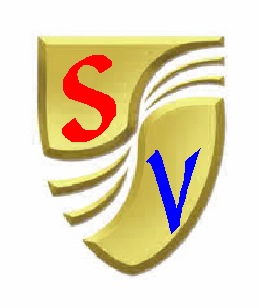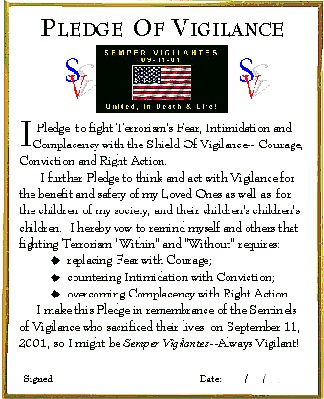 The
VigilanceVoice
The
VigilanceVoice
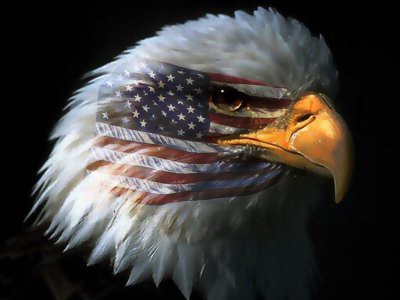
VigilanceVoice.com
Monday-- June 3, 2002—Ground
Zero Plus 264
An Indian, African, Irish
Woman Of Vigilance

by
Cliff McKenzie
Editor, New York City Combat Correspondent News
GROUND ZERO, New York City,
June 3--Janet Jones is as American as you can possibly be...and as
Vigilant as any supporter who has the Courage and Conviction to stand up to Terrorism.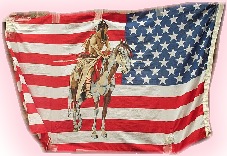 Perhaps it is the mix of her blood that gives her these qualities.
She is a combination of African-American, Native American and Irish
heritage. But she puts her Native American heritage first.
Perhaps it is the mix of her blood that gives her these qualities.
She is a combination of African-American, Native American and Irish
heritage. But she puts her Native American heritage first.
Daily, she flies a unique version of the
American Flag outside her apartment in the East Village of New York City.
It is an American Flag with a portrait of an Indian brave sitting on a
pony, watching the horizon for enemies.
The flag represents her symbol of respect for those
lost in the tragedy of Nine Eleven and her belief the Terrorists attacked
land that belongs to her Indian ancestors. It also stands as a reminder
that the Native Americans are experts at fighting Terrorism.
According to Janet, Indians know what it is like to have their culture attacked, and how to
survive the devastation despite the Fear, Intimidation and Complacency Terrorism brings in
its wake.
The forty-seven-year-old lives with her three poodles. Her
life's passion is learning about
her Native American roots For a
black woman in New York City, it seems paradoxical that her search for
personal identity isn't based on scouring the history of Africa, but
instead, using the majority of each day's 1440 minutes to dig up the
history of the Blackfoot Indians, from which she says a great portion of
her genes flow.
My wife and I met Janet yesterday while
walking along 3rd Street in the East Village. Her flag
caught my attention as it does each time I pass by it. I have seen
it almost daily for the past eight and a half months, but never knew who
owned it, or the story behind its presence. My kinship with
the flag goes back to my own roots.
I grew up in Oregon. I was born
in Hood River and lived also in Cascade Lock. Both towns are built
against the southern shore of the Columbia River, which divides Oregon
from Washington. As a child I occasionally heard my grandparents whispering about our
family's "dark" background. The "dark" secret was we had Indian blood in
us. But it was a taboo to openly discuss the issue. According to my grandparents--
former dirt farmers from Iowa who immigrated to Oregon during the
Depression--to have Indian blood in you was a social shame. I didn't
understand why they were ashamed of that. To me, being an Indian was a
proud quality, one I wanted to embrace.
Indian lore always fascinated me.
Along the Columbia River, the land was rich with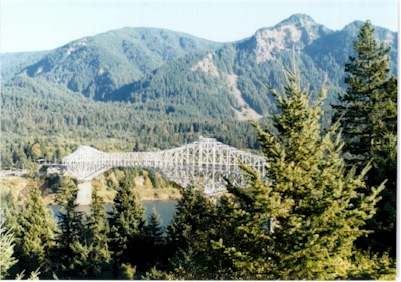 its presence.
At school I waited for that hour when our history class would be taught,
for it was all about the local culture, legends and lore. Cascade
Locks is the home of the "Bridge of the Gods," (photo
on left) named after an Indian legend about a young brave on
one side of the river who fell in love with a girl on the other side.
The two tribes hated each other, causing the Great Spirit to be upset at
them for warring all the time. The legend says the Great
Spirit made a volcano to erupt. It spewed lava into the Columbia
River that formed a bridge so the two lovers could cross from one side to
another, and be together forever. (Note: this is one of many
variations of the legend)
its presence.
At school I waited for that hour when our history class would be taught,
for it was all about the local culture, legends and lore. Cascade
Locks is the home of the "Bridge of the Gods," (photo
on left) named after an Indian legend about a young brave on
one side of the river who fell in love with a girl on the other side.
The two tribes hated each other, causing the Great Spirit to be upset at
them for warring all the time. The legend says the Great
Spirit made a volcano to erupt. It spewed lava into the Columbia
River that formed a bridge so the two lovers could cross from one side to
another, and be together forever. (Note: this is one of many
variations of the legend)
I loved those stories. Being an Indian to
me was all about learning how to have Courage, Bravery and testing one's character, one's
resolve to stand tall in the face of Fear, Intimidation and Complacency.
Thus, the word "Indian Brave," called to me. I wanted so much to
affirm I was "brave," and "courageous."
My favorite fantasy as a young boy besides "Super
Boy" was imagining I was "Golden Arrow," a now defunct comic book character
who rode his Golden palomino into the heart of "Terrorism" to save the
downtrodden and underdogs from the grips of the bad guy. I so wanted
to be "Golden Arrow."
"Golden Arrow," a now defunct comic book character
who rode his Golden palomino into the heart of "Terrorism" to save the
downtrodden and underdogs from the grips of the bad guy. I so wanted
to be "Golden Arrow."
In my youth I spent many hours in the woods
alone with my dog, communing with the trees and plants and playing by the
Columbia River, searching for arrowheads and imagining myself an Indian
brave learning Courage, Conviction and how to take Right Action.
I knew the feathers in an Indians bonnet were not for "slaying" victims,
but represented gifts from other Indians for showing kindness or courage
in helping others. Giving someone a feather was a sign of
respect for being a considerate person, not for being a war monger.
Ultimately, the one with the most feathers was the one with the most
wisdom, the most concern for others--not the biggest bully. He
became chief based on his deeds.
I also knew "war paint" wasn't about war, but
instead was worn by warriors going into battle as a sign of their respect
for the Great Spirit. Should they be killed in the battle, the paint
was their recognition of their respect for the Great Spirit and the
designs on their faces would help them travel safely to the "Other World."
So when September 11th came and I began to
photograph every flag I saw in New York City, Janet Jones' unique
rendition of the American flag leaped out at me. I took
pictures of it from many angles, always wondering who the person was who
owned the flag. I was sure it was an American Indian, I just
never bothered to ask.
Eight and a half months later I found out its
owner was a black woman born with a mixture of heritage and genes--Irish,
African American and Native American--Blackfoot to be exact.
I met Janet yesterday as my wife and I were
walking down 3rd Street. We asked a man sitting on the stoop of an
apartment if he knew who owned the flag. He said if we yelled
up into the window above the flag, the owner, Janet, would respond.
That's what we did.
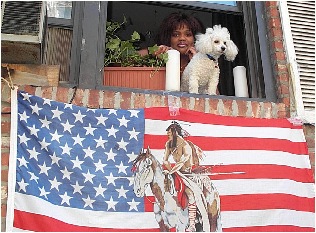 Leaning out the apartment window with her poodle Snoopy standing guard,
Janet told us she had been in Virginia Beach in 1989 when she bought the
flag. She said she thought it was one of the few originals of its
kind, but couldn't verify it. I asked why she flew a flag with an
Indian on it, for it seemed ironic a black woman would be promoting Native
American heritage.
Leaning out the apartment window with her poodle Snoopy standing guard,
Janet told us she had been in Virginia Beach in 1989 when she bought the
flag. She said she thought it was one of the few originals of its
kind, but couldn't verify it. I asked why she flew a flag with an
Indian on it, for it seemed ironic a black woman would be promoting Native
American heritage.
"Just a few years ago I wanted to know more about
where I came from," she said. "I found out from my grandmother that
my great great mother was a Blackfoot Indian, and that I had Irish blood
in me as well. So I began to learn about the Blackfeet.
Now, I study everything I can about Native American history. I love
being an Indian."
Janet said she had no details on what percentage
her Native American heritage included of her genetic makeup, or the amount
of Irish blood. She said her grandmother who was still living looked very Indian.
"I only know I love the history of the Indian. I love the culture.
Each day I learn a little more."
I asked her why she flew that particular flag.
"I wanted to show my respect for the people who died," she replied.
"And, I wanted everyone to know my respect came from my Native American
roots. America, you know, belongs to the Indians.
It's really owned by them."
I smiled in agreement. "And the Mexicans,"
I added. "We took the land from both the Indians and Mexicans.
They were the original owners."
"That's right," Janet smiled.
Janet didn't have to justify an American Flag
with an Indian on it to me. For years I gave lectures
throughout America on the history of our roots. At the time I
was selling franchises, and conducted "The Great American Dream Seminars,"
in which I provided the audience with an historic chronology of how this
country was formed. The word franchise is a French word that
means "to be free from servitude." I cited how the first "slaves" in
America were white--indentured servants--sold to people moving to the New
World to work off their debt. It was later in history that America
began to use slaves from Africa for labor.
My goal in the lectures was to get people to own
their own business rather than work for someone under the principle of
"salaried slavery." Private ownership was the way of breaking
free of servitude. I was very successful because everyone knew that
America was one of the few countries in which a poor person could enter
with nothing, and in a lifetime, applying the principles of free
enterprise, become a wealthy person.
Part of my seminars included the paradoxical
principle of how we acquired our freedom. We came to the New World
to break free of the oppression of monarchies and class distinctions into
which one was born and could never escape. America was to be the
"land of the free and the brave," where anyone from any culture could rise
to the top from the bottom based on hard work and equal rights, regardless
of race, culture, creed or religion through private ownership. All,
that is, except the Indian. Our original Constitution marginalized
the rights of Indians by fractionalizing them when it came to population,
voting and taxes. Article I, Section 2 of the Constitution reads:
|
Article I, Section 2.
Representatives and direct taxes shall be apportioned among the
several states which may be included within this union, according to
their respective numbers, which shall be determined by adding to the
whole number of free persons, including those bound to service for a
term of years, and excluding Indians not taxed, three fifths of all
other Persons. |
We took the Indian's land from them
and placed them on reservations, limiting their rights, abolishing those
they claimed. While we offered equal rights to most everyone, we
denied them to the Indians. Also, many states, but not all, employed
the principles of slavery--ownership of blacks.
Early in our nation's attempt to rid the
land of any Indian claim to it, we took the Indian children from their
parents and put them in eastern boarding schools. The attempt was to
destroy their culture and assimilate them into ours. The children
were taught English and forbidden to speak their language or share the
history of their culture. The theory was by breaking the bonds
of their culture from one generation to the next, we could absorb the
Indians rather than co-exist with them. It was one of America's
great moral stains, ranking equally with slavery. To some, its
intent was more insidious because it took the form of genocide--an overt
attempt to destroy the history of a civilization through assimilation.
Knowing the tenacity of the Native American
culture prompted my interest in saluting Janet Jones' flag.
Indians, I knew, were experts at warding off Terrorism.
They survived the threats to their extinction, caused by the loss of their
land, alcoholism, and an overt attempt to cleave their children from their
history's womb. But as America has matured, and its principles of
"freedom for all" have been put to the supreme test during the 20th
Century, Native Americans have risen in both stature and power as the
forefathers and foremothers of this nation.
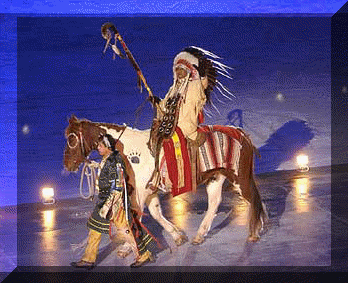
Reparations, however late, have been made.
Economic power has been established through commerce--casinos. The
rights of Indians, as well as the rights of other marginalized minorities,
have grown over the years. And with these rights has come a
new respect for Indian culture.
One prime example is the Winter Olympics recently
held in Salt Lake City, Utah. To kick off the opening ceremonies, American
Indian chiefs from five different tribes rode into the arena and presented
the Olympiads with gifts and blessings from the Great Spirit.
I considered that a tremendous sign of respect honoring the courage of a
culture that stood face-to-face with the Terror of extinction and has
rebounded. I also considered the ceremony to mean that the
world recognized the Indians' rights to give permission to conduct
the Olympics on "their soil."
Janet Jones's flag gave Native American
permission to honor our fallen heroes and victims of September 11th.
I was glad it did. I don't believe the right to the heritage
of the land was sold, but remains always with its original owners.
History reminds us Manhattan was purchased from
the Canarsee Delaware Indians, members of the Algonquin tribes, by Dutch trader Peter Minuit in 1626 for a handful of colored
beads.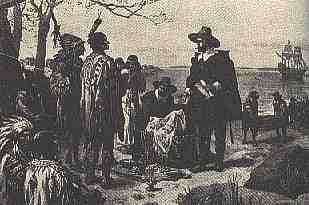 (Actually it was 60 guilders, equal to $24)
(Actually it was 60 guilders, equal to $24)
When the Terrorists attacked the
World Trade Center, they were ultimately attacking property of the
original landowners-- the Native Americans-- its primary historical
caretakers, protectors. (The name, "Manhattan" comes from two
Algonquin Indian words, according to etymologist William Walker
Tooker--"mannah," meaning "island," and the Algonquian suffice meaning
"hills, which is "hatin". "Manhattan" translates to
mean, "hilly island." Other meanings commonly attributed to the word
include: "good place to collect bow wood," "place of general
inebriation," and "people of the whirlpool." Tooker's 1900 research
of the meaning is the most authentic.")
All title searches for real estate in
Manhattan ultimately end up at the first owners-- Indians, not the Port Authority. (The
original deed of ownership by the Dutch traders has been lost in history.)
If one agrees the original owners were Canarsee Delaware Indians, then the
September 11th Terrorist attack was an act of
war not just upon the United States and Democracy, but upon the homeland,
the spiritual property
of the Native Americans. It follows that no flag has more right to fly in honor of
supporting Vigilance for the land than the one Janet Jones flies. It
incorporates both owners--the Native Americans and the United States of
America.
"So," I asked, "how long are you going to fly the
flag?"
"Every day," she replied.
"I understand," I said. "Thanks for your
time."
As I walked away I glanced back at her integrated flag.
The brave in the middle of it was, as far as I was concerned, the
original "Manhattan Sentinel of Vigilance." He symbolized the strength
of Vigilance--its Courage, Conviction and power to take the Right Action to ward off the continuing threats of Terrorism.
I felt good knowing the nearly 3,000
Spirits of Vigilance who died in the Terrorist attack had been joined by a great Indian scout to guide them through the
long days and nights of standing guard over the families and children of Manhattan as well as the rest of the
country.
families and children of Manhattan as well as the rest of the
country.
As I looked into the
sky, I imagined all the Sentinels of Vigilance with headbands and feathers--eagle
feathers--representing their ability to soar in search of Terrorism on the
Wings of Vigilance. The eagle feathers reminded me that we, who are still earthbound,
are charged with the responsibility to not give up our quest for the
Courage to fight Terrorism's Fear, the Conviction to overcome its
Intimidation, or the power to take the Right Action to quash the
Complacency that feeds Terrorism's ability to strike unexpectedly.
Like the Indian on Janet Jones' flag, we must be "brave." We
must stand up to Terrorism, face it, defeat its desire to cripple us with
Fear, Intimidation and Complacency.
"You take care, Mr. Vigilance," Janet yelled as
we walked away.
"I will, Janet," I replied. "And you keep
flying that flag!"
"Oh, you can count on that!" she replied.
Snoopy barked. The wind rustled the flag.
I felt like Golden Arrow.



 Perhaps it is the mix of her blood that gives her these qualities.
She is a combination of African-American, Native American and Irish
heritage. But she puts her Native American heritage first.
Perhaps it is the mix of her blood that gives her these qualities.
She is a combination of African-American, Native American and Irish
heritage. But she puts her Native American heritage first. its presence.
At school I waited for that hour when our history class would be taught,
for it was all about the local culture, legends and lore. Cascade
Locks is the home of the "Bridge of the Gods," (photo
on left) named after an Indian legend about a young brave on
one side of the river who fell in love with a girl on the other side.
The two tribes hated each other, causing the Great Spirit to be upset at
them for warring all the time. The legend says the Great
Spirit made a volcano to erupt. It spewed lava into the Columbia
River that formed a bridge so the two lovers could cross from one side to
another, and be together forever. (Note: this is one of many
variations of the legend)
its presence.
At school I waited for that hour when our history class would be taught,
for it was all about the local culture, legends and lore. Cascade
Locks is the home of the "Bridge of the Gods," (photo
on left) named after an Indian legend about a young brave on
one side of the river who fell in love with a girl on the other side.
The two tribes hated each other, causing the Great Spirit to be upset at
them for warring all the time. The legend says the Great
Spirit made a volcano to erupt. It spewed lava into the Columbia
River that formed a bridge so the two lovers could cross from one side to
another, and be together forever. (Note: this is one of many
variations of the legend) "Golden Arrow," a now defunct comic book character
who rode his Golden palomino into the heart of "Terrorism" to save the
downtrodden and underdogs from the grips of the bad guy. I so wanted
to be "Golden Arrow."
"Golden Arrow," a now defunct comic book character
who rode his Golden palomino into the heart of "Terrorism" to save the
downtrodden and underdogs from the grips of the bad guy. I so wanted
to be "Golden Arrow." Leaning out the apartment window with her poodle Snoopy standing guard,
Janet told us she had been in Virginia Beach in 1989 when she bought the
flag. She said she thought it was one of the few originals of its
kind, but couldn't verify it. I asked why she flew a flag with an
Indian on it, for it seemed ironic a black woman would be promoting Native
American heritage.
Leaning out the apartment window with her poodle Snoopy standing guard,
Janet told us she had been in Virginia Beach in 1989 when she bought the
flag. She said she thought it was one of the few originals of its
kind, but couldn't verify it. I asked why she flew a flag with an
Indian on it, for it seemed ironic a black woman would be promoting Native
American heritage.

 (Actually it was 60 guilders, equal to $24)
(Actually it was 60 guilders, equal to $24)  families and children of Manhattan as well as the rest of the
country.
families and children of Manhattan as well as the rest of the
country.